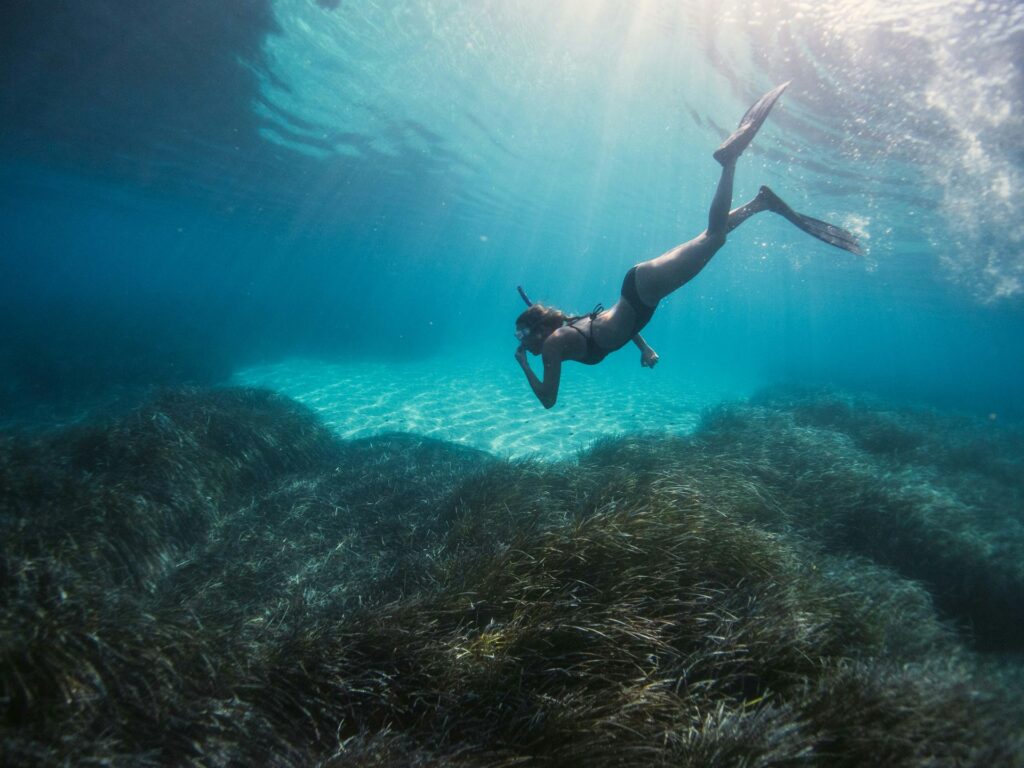How Deep Can You Snorkel?
Lauren Collison May 23rd, 2024 Posted In: Articles
Snorkeling is a great way to explore the subtle depths of the underwater world without the need for heavy equipment or extensive training. But as you become more curious about the underwater wonders, a common question arises: How deep can you snorkel?
Below, we dive into this topic, exploring the snorkeling depth limit, the gear you might need, and important snorkeling safety tips to ensure your underwater adventure is both enjoyable and safe. Read on for more!
How Deep Can You Snorkel?
The question of how deep can you snorkel is both simple and complex. Unlike SCUBA diving, snorkeling is primarily a surface activity, designed to let you enjoy the aquatic world from just below the water’s surface. Typically, snorkelers stay within shallow waters ranging from 1 to 5 meters (3 to 16 feet) deep. This range allows you to float comfortably and observe the underwater scenery without straying too far from the surface.
However, experienced snorkelers who are comfortable with breath-hold diving can dive deeper, usually up to 10 meters (33 feet) for short periods. This practice, often referred to as “skin diving,” requires good breath control and a solid understanding of equalizing pressure to avoid discomfort or injury.
Gear for Deeper Snorkeling
While traditional snorkeling gear includes a mask, snorkel, and fins, exploring deeper depths or more challenging conditions may require additional equipment:
- Snorkel Vest: For added buoyancy and safety, especially if you plan to venture deeper, a snorkel vest can help you stay afloat and reduce fatigue.
- Weight Belt: Experienced snorkelers might use a snorkeling weight belt to help them dive deeper more easily. However, this should only be used if you’re trained in its use and understand how to manage buoyancy and weights safely.
- Wetsuit: Depending on the water temperature, a snorkeling wetsuit can provide thermal protection and additional buoyancy. Thicker wetsuits are better for colder waters and can also add a slight buoyant advantage.
- Free-diving Fins: Longer and more flexible than regular snorkeling fins, free-diving fins can help you swim more efficiently, making it easier to dive deeper with less effort.

Safety Tips for Snorkeling at Various Depths
Safety is paramount when it comes to snorkeling, regardless of depth. Here are some essential tips to keep in mind:
- Always Snorkel with a Buddy: Never snorkel alone. Having a snorkel buddy ensures that someone can help in case of an emergency.
- Stay Aware of Your Surroundings: Be mindful of currents, tides, and marine life. Understanding the local conditions can prevent accidents and enhance your snorkeling experience.
- Equalize Pressure: As you dive deeper, remember to equalize the pressure in your ears to prevent discomfort or injury. Pinch your nose and gently blow to equalize.
- Limit Your Time Underwater: Avoid staying underwater for too long, especially at deeper depths. Ascend slowly and take your time to catch your breath.
- Avoid Hyperventilating: While it might seem helpful to take several deep breaths before diving, hyperventilating can lead to shallow water blackout. Breathe normally and dive within your comfort limits.
The Myth of the “Bends” in Snorkeling
A common concern among new snorkelers is the possibility of getting “the bends,” a condition also known as decompression sickness. The bends occur when nitrogen bubbles form in the bloodstream due to rapid pressure changes, typically associated with deep SCUBA diving. However, this is not a risk for snorkelers who stay within typical snorkeling depths (up to 10 meters or 33 feet). The pressure changes at these depths are not significant enough to cause decompression sickness.
More Snorkeling Tips for a Safe and Enjoyable Experience
- Hydrate and Protect: Drink plenty of water before snorkeling and use sunscreen to protect your skin from sunburn. You could also wear a rash guard to protect your skin from those harmful UV rays!
- Relax and Enjoy: Snorkeling is meant to be a relaxing and enjoyable experience. Take your time, breathe slowly, and savor the beauty around you.
- Respect Marine Life: Look but don’t touch. Many marine creatures are delicate, and some can be harmful if disturbed.
How Deep Can You Go Snorkeling?
While snorkeling is primarily a surface activity, experienced snorkelers can explore depths of up to 10 meters (33 feet) with proper techniques and precautions. Understanding the snorkeling depth limit, using the right gear, and following safety tips will ensure that your underwater adventure is both safe and fun. So, grab your mask, snorkel, and fins, and dive into the exciting world that awaits just beneath the surface!

